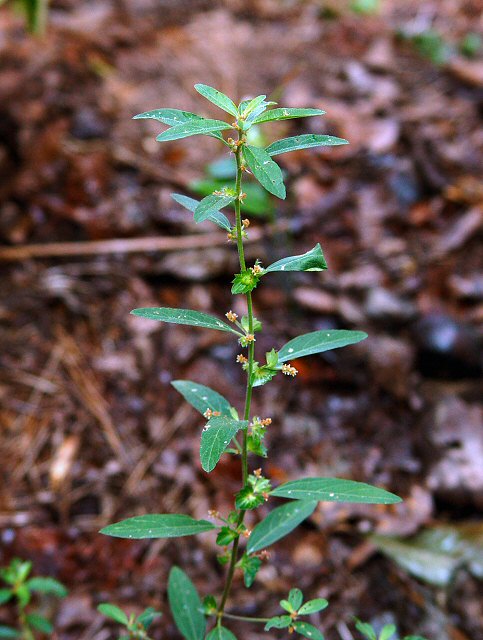Acalypha gracilens A. Gray
Slender Three-Seeded Mercury

Native
CC = 3
CW = 5
MOC = 20
© DETenaglia
Acalypha gracilens A. GraySlender Three-Seeded Mercury | |
 |
Native CC = 3 CW = 5 MOC = 20 |
© DETenaglia |
|
Family - Euphorbiaceae Habit - Taprooted, monoecious, annual forb. Stems - To +40cm tall, erect, simple or branching in the apical 1/2, single from a taproot and fibrous roots, herbaceous, typically reddish at least at the base, appressed pubescent, terete.
Leaves - Alternate, petiolate. Petioles +/-5mm long, antrorse pubescent. Blades linear-lanceolate to linear oblong, to +5cm long, 1cm broad, entire to shallow serrate or crenate, dull green above, light green below, punctate below, antrorse pubescent. Lowest pair of lateral veins emerging at or -1mm above the base of the leaf tissue.
Inflorescence - Brachtiate androgynous racemes to 8-9mm long. Bracts surrounding the pistillate flowers toothed, with 3-5 teeth on each margin, ciliate-margined, antrorse pubescent. Flowers - Pistillate flowers minute, 3-4 per raceme. Ovary densely pubescent, .4-.6mm long. Style pubescent, -1mm long. Petals translucent, .5mm long, ciliate. Fruits pubescent, with one seed per carpel. Staminate flowers dense and terminating the raceme, in a capitate cluster to +/-5mm long. Petals 4, reflexed, cupped and deflexed at the apices, glabrous, whitish to golden yellow, ovate, acute, .4mm long. Pedicels glabrous, .5mm long, jointed in the middle. Anthers curled. Pollen yellow.
Fruits - Fruits 1.5-2.3 mm long, 3-locular, usually 3-seeded, the surface moderately hairy. Seeds 1.2-2.0 mm long.
Flowering - May - October. Habitat - Rocky open glades, rocky prairies, low meadows, rocky open woods, roadsides, railroads. Origin - Native to U.S. Other info. - This little species is found mostly in the southeastern and east-central portions of the state. It is identified by its linear-oblong leaves, short petioles, and three-locular fruits. The general appearance is very similar to the much more common A. monococca, but that species has unilocular fruits. Photographs taken off Lee Rd 54, Auburn, Al., 8-19-04. |